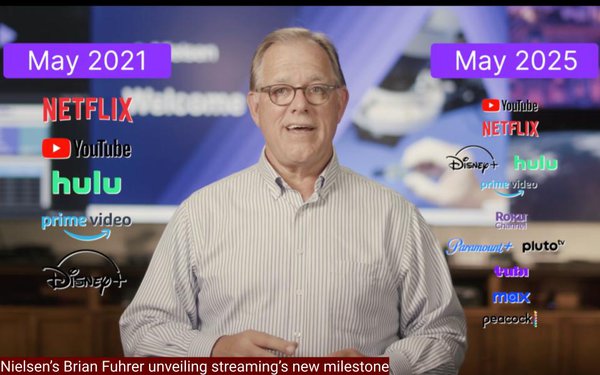
Among other reasons, the news that
streaming passed broadcast and cable TV in total TV usage for the first time in May comes down to a matter of streaming tonnage.
The streaming space has grown and grown to the point where the
overwhelming of broadcast and cable -- gradually or otherwise -- seems inevitable.
In reporting on its research on Tuesday, Nielsen emphasized the way the streaming-legacy balance has changed
in four years, since 2021.
The year was chosen in part to promote The Gauge, Nielsen’s monthly Total TV and Streaming Snapshot of TV usage across all of television that was launched in
2021.
Going back four years also helps to illustrate the dramatic growth of streaming in just that four-year period.
“Comparing May ’21 with May ’25, we see streaming
has increased by 71%, broadcast has dropped by 21% and cable has lost 39% from a usage perspective,” says Brian Fuhrer, SVP of product strategy and thought leadership for Nielsen, in a video posted on Nielsen's website.
advertisement
advertisement
The Nielsen report on TV usage in May has streaming at 44.8% vs. broadcast, 20.1%
and cable, 24.1%.
Combined, broadcast and cable's TV usage adds up to 44.2% -- behind streaming (by 0.6%) for the first time, says Nielsen.
Generally speaking, the legacy side declined markedly since 2021 and the streaming side rose spectacularly -- 71% growth in TV usage in four years, according to Nielsen. By contrast, broadcast and
cable had a combined loss of 60%.
Leading the streaming charge were YouTube Main (Nielsen's name for it) -- excluding YouTubeTV -- growing 120% in four years, followed by Netflix at 27%.
In May, YouTube Main had the largest TV usage share in all of television, 12.5%, besting second-place Netflix, 7.5%.
Four years ago, five streaming services were included in The Gauge's
first report -- YouTube, Netflix, Disney+, Prime Video and Hulu.
More recently, six more have been added because they all met the 1% share-of-TV threshold qualifying them for inclusion in the
data.
The six are subscription streamers Paramount+, Max and Peacock, and fast channels Roku Channel, Pluto and Tubi.
The addition of the three streamers
and the three fast channels is what the TV Blog referred to as “tonnage” above. To paraphrase an old saying: God must really love streaming services -- he made so many of
them!
So, what are the owners of broadcast and cable channels supposed to do now? Where basic cable is concerned, we are seeing changes all over the place in the way they are
held and managed by their parent companies.
Most notably, Warner Bros. Discovery and NBCUniversal have split their basic-cable channels into separate companies.
The basic cable
channels owned by Paramount Global face an uncertain future as Paramount attempts to close its merger deal with Skydance.
Maybe it is too early to write a eulogy for broadcast television.
Nielsen's Fuhrer says that, at least for now, the situation in May is not necessarily permanent.
“This fourth anniversary milestone of streaming exceeding broadcast and cable is almost
certainly not permanent,” he says. “We may see it continue into the summer months, but as football kicks off and a new broadcast season returns, the balance will likely shift back at least
temporarily.”
And once again, professional sports rights are presented as the key to broadcast survival, if they can afford it.
But as Fuhrer pointed out earlier in his analysis of the Gauge report, Netflix “owned the biggest day in the history of streaming [last year], thanks to two NFL games last Christmas
Day.”